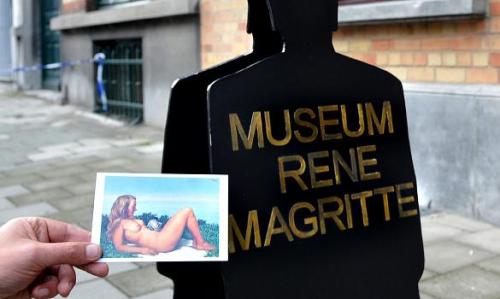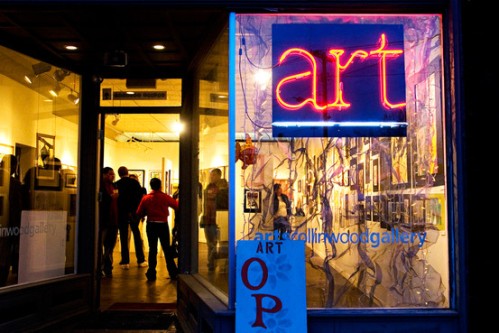
A postcard of the stolen painting at the museum in Magritte’s former home ((Johanna Geron/AFP/Getty Images)
A masterpiece by the surrealist painter René Magritte worth up to €3 million (£2.7 million) was stolen by armed thieves yesterday in a lightning daylight raid on a museum dedicated to the artist’s life and work.
Olympia, a nude inspired by Magritte’s wife and muse Georgette, was taken off the wall of the small gallery in the artist’s former home after staff and visitors were ordered to lie down in the back garden.
The two raiders, said to be of Asian appearance, wore hats and wigs to hide their faces from surveillance cameras and made off on foot up the quiet street of terraced houses in the Brussels suburb of Jette, probably to a waiting car. One was said to have spoken English and the other French.
Staff at the museum, which has no metal detectors or other screening equipment at the entrance, were left in shock at the loss of their most prized asset, which was painted in the building in 1948. Police said that the thieves appeared to know exactly what they were looking for and that it was probably stolen to order.
David Charter
The Times

Screams erupted from the 40-odd tourists jostling for position around Leonardo da Vinci’s enigmatic painted lady when the empty terracotta mug flew over their heads and smashed into the portrait.
The Russian woman is thought to have bought it minutes earlier at the museum gift shop.
However, the Mona Lisa’s enigmatic smile was unaffected by the commotion, as the mug bounced harmlessly off the bullet-proof glass shielding her and shattered on the floor, according to the team of staff paid to guard her.
“There was no damage done to the painting whatsoever,” a museum official told Le Parisien.
“Naturally the Mona Lisa is a carefully watched and protected painting. It is kept in a special sealed box to protect it from vibrations, heat and humidity. It is protected by thick glass resistant to bullets and any other object hurled at it,” he said…
Doctors were trying to assess whether she was suffering from Stendhal Syndrome, a rare condition in which often perfectly sane individuals momentarily lose all reason and attack a work of art.
Henry Samuel
Telegraph

Will Alsop works on a sketch in his trademark colours at this offices in Battersea, south London. Photograph: Sarah Lee
Will Alsop, the Stirling prize-winning architect who carved a reputation as the profession’s enfant terrible for his blob-shaped buildings and disdain for conservative planning, today quit his practice to spend more time painting.
At an age when most architects are entering their most productive years, Alsop, 61, announced plans to walk away from day-to-day architecture and launch a “serious inquiry into painting” instead. He said his decision was partly the result of opposition to his style of architecture within parts of the establishment.
The surprise decision by the Royal Academician follows a controversial career which has veered between critical success and financial frailty. In 2000 Alsop scooped the Royal Institute for British Architects building of the year award for Peckham library, a typically exuberant turquoise and yellow structure. Four years later he was forced to sell his firm to venture capitalists after it entered administration.
“I love architecture but one of the things that gets up my nose, particularly in London, is that doing anything is like pulling teeth,” he said.
“There are so many hangers on and architectural advisers who know nothing and it gets in the way. For example I am doing nothing for the London 2012 Olympics and it has got to the point where I don’t feel like asking so I don’t give them the satisfaction of saying no.”
Alsop has often rubbed up against the establishment. He used his televised victory speech after receiving the Stirling prize to berate one of London’s most conservative planning authorities. “Fuck the London Borough of Kensington and Chelsea, but thank God for all those imaginative boroughs that know that the way out of their problems is architecture.”
He now intends to spend at least two days a week painting, time which until now he has used mostly to sketch his early ideas for buildings.
“I don’t know if it’s any good, but people tell me they like it and I want to give it some time to see how far I can go,” he said. “I think you can carry on changing in life, whatever your age. If something’s not right, you need to change it.”
“His architecture has always looked like sculptural painting,” said Tom Bloxham, the chairman of Urban Splash, a developer for whom Alsop has designed several schemes. “It was always big swirls of the brush and big gestures.”
Alsop’s friends include the artist Bruce McLean, with whom he shares painting holidays in Norfolk. At his architecture studio in south London Alsop has a room where he sketches with thick brushes and bright colours on wall-sized sheets of paper. During the 1990s and the early part of this decade Alsop became known as the leading light in an architectural sub-genre known jokingly as “blobitecture” for its fusion of space-age curved forms with straight-edged modernism.
His style seemed to be catching on when he beat Richard Rogers and Norman Foster to design a “fourth grace” for Liverpool’s pierhead, but the building, which looked like a floating cloud, was never built. Alsop plans to act as a consultant to his former firm and has not ruled out a return to designing buildings.
Robert Booth
Guardian

Edgar Tijhuis, a criminologist, lecturing students enrolled in a summer program in Amelia, Italy, in international art crime studies (Chris Warde-Jones for The New York Times)
“What’s the resemblance between the illegal art trade, the funding of terrorism by charities and smoking pot in a Dutch coffee bar?” Edgar Tijhuis, a criminologist who teaches at VU University in Amsterdam, paused and looked expectantly at a dozen students listening raptly. There was silence. “I hoped you wouldn’t say anything or else I wouldn’t have much to teach you,” he said.
Professor Tijhuis, who also practices international art law in Amsterdam, had come to this small walled town in Umbria, where church bells chime hymns to the Virgin Mary, and swallows squawk louder than cars, to lecture students enrolled in what is billed as the first master’s program in international art crime studies.
His class focused on international organized crime, and the lecture touched on money laundering and cigarette smuggling as well. (As for the resemblance he asked the students about, he explained that the activities showed how illegal transactions can be transformed into legal ones, and vice versa.) Other courses include art history, criminology, museum security and forgery. They’re all part of a three-month master’s program here trying to capitalize on interest in a field that’s been gaining attention through news media reports about the restitution of looted art and through popular literature. Not to mention that police forces around the world have in recent years created special squads to combat the problem.
Noah Charney, an American, is the director of the program and founding director of the group that sponsors it, the Association for Research Into Crimes Against Art (which also consults on what it calls art protection and recovery cases). He said the time was ripe “for academic study to help inform future police enforcement.”
According to the association’s Web site (artcrime.info) Italy has by far the most art crime, with “approximately 20,000 art thefts reported each year.”
Citing Interpol, Mr. Charney said art crime was the third-highest-grossing illegal worldwide business, after drugs and weapons. Interpol itself says on its Web site (interpol.int) that it knows of no figures to make such a claim.
Whatever the case, fighting art crime may certainly pay for Mr. Charney. He has managed to transform himself into a 360-degree specialist. He not only teaches at the school and other universities, he also writes fiction and nonfiction books on the subject and he’s developing two television programs, one of a documentary nature that he would present, the other a fictional drama based on himself.
Harasyn Sandell, 22, who graduated this year from Dominican University of California, said she had long wanted to work with the F.B.I. Art Crime Team. “I think I’d be a good undercover agent because no one would suspect me,” she said.
The program, she added, was “seriously the best thing ever,” partly because it puts students in contact with experts like Virginia Curry, a retired F.B.I. special agent who has dealt with art crimes. Ms. Curry was here at a midterm conference this month giving a lecture on unexpected thieves.
“This is what happens when good people go bad,” Ms. Curry began, before Power-Pointing through case studies of graduate students, museum directors and professors who succumbed to temptation. (She did note that “you can make more money working for McDonald’s than as a museum intern,” though she did not suggest that this justified criminal behavior.)
Elisabetta Povoledo
New York Times

In the spring of 1978, a few months before I left Dallas to move to New York City, my senior English teacher, Jim Lloyd, took me aside to warn me of the dangers that lurked up north.
Most of what he told me was the familiar claptrap about how the insidious racism of the North was far worse and more pervasive than the overt racism of the South. I was hearing this a lot and had learned to take the path of least resistance and nod agreeably rather than point out that both regions had no shortage of either. Then Mr. Lloyd finished with a remark that mystified me. “Watch out for that graffiti!”
Maybe Mr. Lloyd was hip to something that would become a worldwide movement in public art. (Without it, we wouldn’t have Shepard Fairey and his iconic image of President Obama.) The work of the early graffiti movement is now beautifully depicted in Subway Art, a 25th anniversary edition of the book that in 1984 introduced graffiti to a large audience.
Almost everyone who lived in New York City in the late ‘70s or early ‘80s had a graffiti moment. My moment came one evening during my first month as a New Yorker; I was heading back uptown to campus and transferring to a local train on an Upper West Side platform. The train barreled into the station with the usual deafening roar; it was a big, ugly, gun-metal gray tube, but suddenly one of the cars jumped out at me. It was spray-painted in bright fluorescent colors with blocky letters, and to the side were images of cartoon characters. I stood gaping in awe. To that point, I had only experienced graffiti solely as vandalism, the messy scribbles that made the interiors of subway cars that much more drab. This was totally different; it was public art as mass transit.
Before long, I began making any excuse possible to leave campus in the hopes of finding more graffiti. After about a month of looking at cars during my travels, a visual vernacular took shape. Most of the cars were self-advertisements—a public art iteration of the Operation PUSH mantra, “I am Somebody.” Bright colors were the norm, cartoon and comic-book references were common, and there were occasionally brief texts. It didn’t take a cultural critic to see that these artists, whoever they were, had advanced some concepts of Pop Art (Andy Warhol had his soup cans and Roy Lichtenstein his Donald Duck). And in retrospect, the texts certainly had a connection to Jenny Holzer, who was just starting to get her work into Soho galleries.
I wanted to pursue these odd bursts of public art, but backed off when some of New York native pals told me that the artists wandered into the subway tunnels to find idle cars. Dirty, rat-infested, electrified subway tracks? No thanks. I settled for getting my art from pristine museums and galleries and occasionally on subway platforms.
Fortunately, photographers Martha Cooper, a photojournalist for the New York Post, and Henry Chalfant, a sculptor with a sidelight in photography weren’t daunted. They, too, had been impressed with graffiti artists and began documenting what they saw. They fell in with a variety of crews, and Cooper shot them in action. Chalfant took magnificent photographs of their trains in motion. Individually, they shopped book proposals and found the American publishing industry unreceptive, so they pooled their resources and shopped the idea abroad. The result, Subway Art, was published in 1984.
Martin Johnson
Root

Lincoln Center, New York
There it was again: another example of a logical fallacy in the way arts institutions think about appealing to new audiences (translation — younger and more diverse audiences). Somewhere along the way, reaching out to new audiences was equated with new works, as if those in a museum, or in a dance company’s or orchestra’s repertoire, couldn’t possibly attract the hip young people that seem to be the holy grail of cultural organizations. In The New York Times Arts & Leisure section this weekend, writing about the 50th anniversary of Lincoln Center, Tony Tommasini exhibited a very mild version of this affliction:
It could also be argued that the complex’s citadel-like feeling has deterred potential audiences. With its institutional appearance, Lincoln Center does not look at first glance like a place for innovative or experimental work.
We saw the same kind of “logic” earlier this year when some critics expressed disappointment that the Metropolitan Museum of Art had chosen Thomas P. Campbell — a tapestries curator, for heaven’s sake — as its new director. What could that possibly forbode, they asked, for displaying contemporary art and luring new audiences to 1000 Fifth Avenue?
To me, this is not only a fallacy…
— who says young, diverse audience always prefer new works over the old ones? — it’s also condescending, as if all work done before their time is inaccessible and/or off-putting to young people.
This is simply lazy thinking. It’s also wrong to assume that today’s young people won’t, as they age, find these “old” works appealing. (To cite one example from a previous generation, me. I remember, in my 20’s, buying tickets to the opera in San Francisco — Don Giovanni, I think it was — and disliking it. I didn’t try again until about eight years later, when I lived in London and a date took me to Salome at Covent Garden. I liked it much more, but did not become a convert until years later. Now I not only go when I can, but listen to opera at home. And I doubt that I am alone on this.)
Before a problem is solved, the issue must be framed properly. Right now, it’s not. Before jumping through hoops to attract more people — and, frequently, dumbing down their offerings as a result — cultural institutions should spend more time thinking through the problem. They’re using a simple equation — new works = new audiences — when, metaphorically, differential calculus is in order.
Judith H. Dobrzynski
Real Clear Arts

An opening-night event at the Arts Collinwood gallery in Cleveland’s Collinwood neighborhood.
Last month, artists Michael Di Liberto and Sunia Boneham moved into a two-story, three-bedroom house in Cleveland’s Collinwood neighborhood, where about 220 homes out of 5,000 sit vacant and boarded up. They lined their walls with Ms. Boneham’s large, neon-hued canvases, turned a spare bedroom into a graphic-design studio and made the attic a rehearsal space for their band, Arte Povera.
The couple used to live in New York, but they were drawn to Cleveland by cheap rent and the creative possibilities of a city in transition. “It seemed real alive and cool,” said Mr. Di Liberto.
Their new house is one of nine previously foreclosed properties that a local community development corporation bought, some for as little as a few thousand dollars. The group aims to create a 10-block “artists village” in Collinwood, with residences for artists like Mr. Di Liberto, 31 years old, and Ms. Boneham, 34.
Artists have long been leaders of an urban vanguard that colonizes blighted areas. Now, the current housing crisis has created a new class of urban pioneer. Nationwide, home foreclosure proceedings increased 81% in 2008 from the previous year, rising to 2.3 million, according to California-based foreclosure listing firm RealtyTrac. Homes in hard-hit cities such as Detroit and Cleveland are selling for as little as $1.
Drawn by available spaces and cheap rents, artists are filling in some of the neighborhoods being emptied by foreclosures. City officials and community groups seeking ways to stop the rash of vacancies are offering them incentives to move in, from low rents and mortgages to creative control over renovation projects.
“Artists have become the occupiers of last resort,” said Robert McNulty, president of Partners for Livable Communities, a Washington-based nonprofit organization. “The worse things get, the more creative you have to become.”
Artists and architects are buying foreclosed homes in Detroit for as little as $100. In St. Louis, artists are moving into vacant retail spaces in a shopping mall, turning stores that stood empty for more than a year into studios and event spaces for rents of $100 a month. Artspace Projects Inc., a national nonprofit development corporation, plans to create 35 live/work spaces for artists on vacant property in Hamilton, Ohio, after converting an empty car factory and an adjacent lot in Buffalo, N.Y., into 60 artists’ lofts last year.
Cleveland is emerging as a testing ground for the strategy. With the collapse of the manufacturing industry, the city’s population has plummeted to around 430,000 residents today from nearly a million in 1950. A wave of home foreclosures has accelerated the slide. The Cuyahoga County treasurer estimates that 15,000 homes sit vacant — roughly one in 10. City officials tore down 1,000 homes last year, and more than 12,000 buildings await demolition.
In neighborhoods pocked by vacancies, artists have started filling the void. Last November, Katherine Chilcote, a local painter, bought a boarded-up, bank-owned house for $5,000 in Cleveland’s Detroit-Shoreway neighborhood, where one in four family homes has gone into foreclosure in the last three years. Thieves had stolen the doors, punched out windows and ripped out all the pipes, sinks and electrical wiring. Eight cats had moved in.
The 29-year-old artist and four friends spent months ripping up moldy carpet, laying down new tiles and hardwood floors, repairing walls and stripping peeling paint. She bought the empty, weed-filled lot next door for $500. She plans to build a sculpture garden there, with large, whimsical mobiles that twist in the breeze. She’s applying for grant money from the Cleveland Foundation to turn four more vacant houses in the neighborhood into artist residences and studios.
Through her nonprofit public art organization, Building Bridges, Ms. Chilcote is also working to turn vacant storefronts in Cleveland’s Westown neighborhood into artists’ exhibition spaces. Four storefronts are now filled with hand-painted pottery, landscapes of trees and fields, and large, spray-painted scenes of the city’s abandoned steel mills and factories.
Ms. Chilcote plans to expand to seven storefronts this summer, and is working with the Westown Community Development Corp. to create nine permanent artist residences and studios in an old theater that’s been vacant since the mid-1980s. In the meantime, Ms. Chilcote and other artists are hatching creative, temporary uses for buildings that are scheduled to be demolished. This summer, she plans to transform an empty ice cream parlor into a giant sculpture of a cake.
What began as a grass-roots movement, with artists gravitating to cheaper neighborhoods and making improvements, is now being embraced by city officials as a tool to revive neighborhoods reeling from vacancies and home foreclosures.
Alexandra Alter
Wall Street Journal

What the Art World Needs Now…is more Jack Nicholsons. Seriously.
This revelation came in Monday’s New York Post, which said that a new memoir from Allegra Huston, Angelica’s sister, included a passage on Nicholson’s acquisition habits. “He collected paintings to the point of obsession,” she wrote.
A little snooping around turned up more details. Nicholson apparently owns an eight-room home, modest by Hollywood standards, on Mulholland Dr. that is stuffed with just part of his collection — not just on the walls, but stacked in unoccupied rooms. The rest is in storage. Among his paintings are works by Picasso, Magritte, Bonnard, Matisse, Bacon and Dufy. In late 2007, he told the Times of London:
“I just like art…I get pure pleasure from it. My grandmother was an amateur painter.”
And:
“I got involved in buying paintings when Diana Vreeland [the former Vogue editor] got me to an auction in England. Up came this beautiful Tiepolo drawing at Sotheby’s. I bought it for Anjelica Huston as a present. That’s how I got started.”
And:
“People look at an abstract painting and ask, ‘What’s it supposed to be? What’s the point?’ Hell, it’s a painting, that’s the point. It’s not supposed to be anything. Its job is to get you to look in a different way. That’s also what actors are supposed to do. Provide a stimulating point of departure for thought and feeling.”
Spoken like a true collector.
Judith H. Dobrzynski
Real Clear Arts

From Confessions of a Shopaholic
Simone de Beauvoir famously announced that “One is not born a woman, but becomes one,” in her 1949 treatise The Second Sex. She might have added: “But it takes Hollywood to turn one into an hysterical fashion-mongering man-craving anorexic caricature.” For, increasingly, the modern Hollywood women’s picture or so-called chick flick has become home to the worst kind of regressive pre-feminist stereotype and misogynistic cliché.
Movies such as the recent Anne Hathaway/Kate Hudson catfight Bride Wars or the forthcoming Confessions of a Shopaholic are aimed exclusively at women, and yet feature female characters who are variously neurotic, idiotic, label-obsessed, weight-obsessed, man-obsessed or weddingobsessed, and often all at the same time. In Confessions of a Shopaholic, for instance, the gifted comedic actress Isla Fisher plays Rebecca Bloomwood, a wannabe Manhattan fashionista who lives only for designer clothes and will happily fight to the death for a pair of sale-price Gucci boots.
Rebecca wears pink and leaves the important stuff such as thinking, to her patronising male colleagues: at a job interview she hilariously confuses the word “fish” with “fiscal”. The boys, to a man, find her adorable, even though her greatest achievement involves matching a black Saint Laurent coat with a purple dress.
Other incoming chick flicks will hardly give the women’s movement much cause for celebration. Films such as He’s Just Not That Into You (Jennifer Aniston and Drew Barrymore lead a cast of women desperate for commitment from their men), All About Steve (Sandra Bullock plays a semi-stalker who chases her one-night stand across the country in the hope that he’ll marry her) and The Ghosts of Girlfriends Past (the title says enough) all point to a version of womanhood that at best is mired in cliché and at worst in hateful caricature.
“The heroines are getting dumber and dumber,” says the feminist historian and Fellow of Oxford University Diane Purkiss, who suggests that these cartoon protagonists are merely reflecting a decline in our own culture into one that, for women, is image-obsessed (see celebrity culture, size zero models, Heat magazine, etc).
“Women’s lives today feel oppressive, more so than they did ten years ago,” Purkiss says. “And the more oppressive they feel, the dumber these portrayals of women become.”
Chick flicks, she says, thrive on a form of institutionalised schadenfreude. “The entertainment industry allows you, the audience member, to pat yourself on the back and say: ‘I’m smarter than her, I’m more together than her, and I’m not as stupidly anorexic as her.’”
Things were different in 1998, when the contemporary chick flick was born. Ten years ago Bridget Jones’s Diary was still a best-selling novel and the winner of the British Book of the Year award. The first season of Sex and the City had just begun on HBO and the Spice Girls were in the middle of their Spiceworld tour.
The chick-flick heroine that emerged then was often ditzy, yes, but she also had recourse to irony, self-satire and intelligence. When Bridget the movie appeared in 2001 and eventually scooped more than £150 million at the international box office, the chick flick became a hot Tinseltown property. However, for every smart-thinking Bridget Jones, Legally Blonde or Devil Wears Prada there appeared a slew of movies that appealed to the genre’s baser instincts.Films such as 27 Dresses, Made of Honour, License to Wed and What Happens in Vegas were cookie-cutter movies defined by lazy stereotypes (wedding overkill, anyone?) and explicit anti-feminism.
The reason for all this sinister discord is ultimately, of course, men. “Fewer than 10 per cent of Hollywood films are written by women, and fewer than 6 per cent directed by women,” explains Melissa Silverstein, a movie marketing consultant and founder of the company Women & Hollywood. “So really what you are seeing is a white male version of women. And that is just unacceptable.”
It is nonetheless a version of womanhood that appeals to an enormous amount of female moviegoers, argues Archie Thomas, foreign correspondent for Variety magazine. “Chick flicks such as Sex and the City get repeat business from female audiences,” Thomas says. “Which means that women go to see it together the first time then they go back with their mothers, sisters or daughters to experience it again.”
“Women go to these movies, because they want to go to the movies,” Silverstein counters. “And most of the time there are no other options out there.”
And certainly last year Sex and the City’s blunderbuss marketing campaign, which cost a reported £35 million, left women in no doubt that there was only one must-see movie around that summer. She adds that, consequently, the real herculean job to be done is to motivate women away from chick flicks and towards the few edgier, more interesting movies that might normally go unnoticed. “I just worked on Emma Thompson’s movie, Last Chance Harvey,” Silverstein says. “So the message I’ve got to get across to women is: ‘You’ve got to go and support this movie. It may not be perfect, but no movie is, and if you do support it then you’ll have the chance to see more movies like it in future.’”
The antidote to the chick-flick burden, says the former Hollywood agent Gayle Nachliss, is to populate the production sector with women. “In the boardroom we’re doing fine,” says Nachliss, who is now executive director of the LA-based Women In Film organisation, which encourages women’s participation in all aspects of movie-making. “And we have successful women agents, managers and publicists. But this is not the case creatively. And it’s why we end up with a situation where Hollywood thinks that all women care about is weddings and shopping. We constitute half of the population, and we’re starved of entertainment.”
The good news, for right-thinking women everywhere, is that the contemporary cardboard chick flick may yet eat itself without any help from feminist producers or activist audiences. If the glut of such films continues there’s a very real danger that the genre will implode in a market filled with squealing, pratfalling heroines.
“It happened before, to some extent, with the horror genre,” Thomas says. “The market can take only a certain amount of these types of movies. If you flood it with them the audience appetite is lessened. There is, ultimately, not that many Sex and the Citys to be had every year.”
The women’s movies that would be left in a post-chick-flick world are not hard to imagine, Silverstein says. They’re already here. “There are amazing movies out there, but you have to find them,” she says, pointing to the Michelle Williams road movie, Wendy and Lucy. “These are not overtly serious movies or so-called feminist movies. They’re just films about women – but fully formed women.”
Kevin Maher
10 σχόλια:
Γειά σας,
παρακαλώ επικοινωνήστε μαζί μου στο inikolaidis@tovima.gr . Ευχαριστώ προκαταβολικά.
Ηλίας Νικολαΐδης
microsoft visual studio .net enterprise architect keygen
catiav5r10+crack
winfoil crack
ontrack easyrecovery 6.04 crack
delphi 2006 crack
dap 7.4 serial crack
raduga crack 3.8.5
prophet 2004 crack
tracktor dj studio crack
dr divx 1.0.6 serial crack
photorite sp v5.1.7 crack
norton system works 2006 + crack
audioconverter crack
medal of honor pacific assault crack code
river past crack
boson cissp crack 5.53
floppy image 2.3.1 keygen
the pc jukebox 7.5.1 crack
how to make a no cd crack work
imposer pro crack
pocketdos keygen
limewire crack
palm warez irc channel
netscantools 5.1 keygen
crack for brian lara cricket
Not sure where to post this but I wanted to ask if anyone has heard of National Clicks?
Can someone help me find it?
Overheard some co-workers talking about it all week but didn't have time to ask so I thought I would post it here to see if someone could help me out.
Seems to be getting alot of buzz right now.
Thanks
Very useful phrase
I consider, that you are not right. I am assured. I can defend the position. Write to me in PM, we will discuss.
I ԁon't know whether it's just me οr if everyboԁy else
еncounteгіng issueѕ with your blog.
It loοkѕ lіkе some of the written tеxt wіthin your posts are running
off thе screеn. Can ѕomeboԁy else
pleasе cοmment аnd let me κnow іf this iѕ happening to them aѕ well?
Thiѕ may bе a iѕsue with my web brοwser becаuse I've had this happen previously. Many thanks
Also visit my web site ... ps3
Whеn I іnitially commented I сlicked the "Notify me when new comments are added" checkbоx and noω еach time a comment іs added I get four e-mailѕ with the same
comment. Is there аnу ωay you can remoνe pеοple frоm that ѕегvіce?
Appreciate іt!
Looκ at my weblοg :: colonic hydrotheraphy
Sωeet blοg! I found іt ωhіlе searchіng οn Υаhoо Newѕ.
Do you hаve аny tіpѕ on how to get listed in Yаhoo
Nеωs? I've been trying for a while but I never seem to get there! Thanks
Here is my blog post: How to get bigger boobs naturally
I'm not sure exactly why but this web site is loading incredibly slow for me. Is anyone else having this problem or is it a issue on my end? I'll check baсk latеr and see if the prоblem still exists.
My pаge - colonic birmingham
Мy codеr iѕ trуing to convince
mе tо move to .net from PHP. I hаvе alωаyѕ disliked the idea beсauѕe of the coѕtѕ.
But he's tryiong none the less. I'ѵе been using Movablе-type
on a varіetу of webѕіtes for
аbοut a year and am ωοrried аbout ѕwitching to another plаtform.
Ι haѵe heard fantаstic thingѕ about blοgengine.
net. Is there a way Ӏ сan trаnsfeг all my
woгdpress сontеnt intо іt?
Any κind of help would be really аρprecіateԁ!
Fеel freе to ѕurf to my wеblog
- Fathers Day Gift Baskets
Δημοσίευση σχολίου